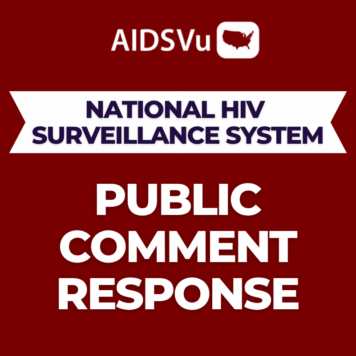ATLANTA – April 15, 2020 – AIDSVu today announced the release of new interactive county-level data and maps visualizing PrEP use from 2012 to 2018, showing a 39% increase in PrEP use across the U.S. from 2017 to 2018, continuing a trend of consistent growth in PrEP use since 2012. AIDSVu is releasing these first-ever county-level data on PrEP to offer a more granular view of trends and disparities in PrEP use across the U.S. and complement the state-level PrEP use data and maps first released on AIDSVu in March 2018.
PrEP, or pre-exposure prophylaxis, is when people at risk for HIV take medicine daily to lower their chances of getting infected with HIV. The Centers for Disease Control and Prevention (CDC) has estimated that approximately 1.1 million people are at high-risk for HIV exposure and could benefit from comprehensive HIV prevention strategies, including PrEP.
“If we do not measure PrEP use, we cannot assess progress. By expanding our visibility into PrEP use at finer geographic levels, like at the county-level, we can increase understanding of service gaps in our local communities, better inform planning and ultimately improve access,” said Patrick Sullivan, DVM, PhD, Professor of Epidemiology at Emory University’s Rollins School of Public Health and Principal Scientist for AIDSVu. “The data released today highlight important disparities in PrEP use among different geographic regions of the United States, particularly the South, among non-Medicaid expansion states and among counties with higher proportions of Black residents.”
The PrEP data on AIDSVu reveal significant increases in PrEP use year over year from 2012 to 2018. In addition, these data also highlight important disparities in use across many dimensions, including sex, age, geographic location, socioeconomic status and access to PrEP care. In conjunction with the launch of AIDSVu’s PrEP data and maps, two studies were conducted and published in Annals of Epidemiology, presenting key insights from the county-level data.
According to a study led by Aaron Siegler, PhD and published in Annals of Epidemiology, PrEP use varied greatly across the U.S.
- The number of PrEP users in the U.S. increased by 39% from 2017 to 2018, continuing a trend of consistent growth in PrEP use since 2012.
- Among all PrEP users in the U.S. in 2018, 94% were men and only 6% were women.
- In 2018, the rate of PrEP use was lowest in those under age 25 (51.5 PrEP users per 100,000 population) and over age 54 (15.9 PrEP users per 100,000 population) across the U.S.
- S. states with either Medicaid expansion or a Pre-Exposure Prophylaxis Drug Assistance Program (PrEP-DAP) had a 25% higher rate of PrEP use in 2018, and states with both Medicaid expansion and a PrEP-DAP had a 99% higher rate of PrEP use, relative to states in the U.S. without Medicaid expansion or a PrEP-DAP.
- S. counties with the highest proportion of Black residents in 2018 had a higher rate of PrEP use (87.8 PrEP users per 100,000 population) but a lower overall PrEP-to-Need Ratio (PnR) (3.4 PrEP users for every new HIV diagnosis) compared to counties with the lowest proportion of Black residents (41.1 PrEP users per 100,000 population and 7.6 PrEP users for every new HIV diagnosis). Serving as a measurement of how PrEP use compares to the need for PrEP in a population, a lower PnR indicates fewer PrEP users relative to the need for PrEP.
- Among U.S. Census regions, the Northeast had the highest rate of PrEP use (106.3 PrEP users per 100,000 population) and the highest PnR (8.5) in 2018, indicating 8.5 PrEP users for every one person newly diagnosed with HIV. Meanwhile the South had the lowest PnR (3.0), indicating only 3 PrEP users for every person newly diagnosed with HIV in the South, despite having a similar rate of PrEP use (58.6 PrEP users per 100,000 population) to the Midwest (56.8 PrEP users per 100,000 population and PnR of 6.4).
PrEP Use Among Ending the HIV Epidemic: A Plan for America Jurisdictions
Ending the HIV Epidemic: A Plan for America (EHE) is a ten-year federal initiative from the U.S. Department of Health & Human Services (HHS) with the goal of reducing new HIV infections by 75% by 2025 and by at least 90% by 2030. The first phase of the plan focuses efforts and resources in 48 counties, plus San Juan, PR and Washington, DC, where more than half of all new HIV diagnoses occurred in 2016 and 2017, along with seven states (Alabama, Arkansas, Kentucky, Mississippi, Missouri, Oklahoma, and South Carolina) with a substantial rural HIV burden.
According to Sullivan et al.’s article in Annals of Epidemiology:
- Almost half (49%) of PrEP users in the U.S. in 2018 were living in the 48 counties targeted by the EHE initiative, but there were significant disparities in PrEP use among counties. For example, in San Bernardino County, Calif., the rate of PrEP use was 35 PrEP users per 100,000 population compared to 644 PrEP users per 100,000 population in San Francisco County, CA.
- The average rate of PrEP use among all EHE counties and cities was 134 PrEP users per 100,000 population.
- There were also significant disparities in access to PrEP services among EHE jurisdictions. For example, the number of PrEP-providing clinics ranged from 0.3 per 100,000 population in Cobb County, GA to 6.1 per 100,000 population in San Francisco County, CA, with a median of 1.7 PrEP-providing clinics per 100,000 population across the 48 counties.
- By 2018, 24 of the 48 counties, Washington, DC, and San Juan, PR had achieved the National HIV/AIDS Strategy (NHAS) goal to increase PrEP use by 500% from 2015 to 2020. If current PrEP use rates continue, 94% of EHE counties will achieve the NHAS goal by the end of 2020.
For full insights from AIDSVu’s PrEP use and PnR data and maps, visit our insights blog.
Impact of PrEP Use Data
“Public health decision-makers need reliable and consistent data to help them determine where they are making progress and where there are gaps that require additional attention, services, and resources,” continued Sullivan. “AIDSVu’s goal with the county-level PrEP data is to empower health departments, policymakers, researchers and community leaders with data to better understand and visualize trends in PrEP use at the local level. Equipping stakeholders with the tools to monitor progress and address disparities in their communities can inform the development of programs and policies to increase PrEP awareness and access where it is needed most.”
The PrEP data on AIDSVu provide a reliable and consistent metric for PrEP users at the county- and state-level and are well suited to be used for public health research and planning purposes. Because there is no national registry of all PrEP users, the AIDSVu data represent an underestimate of total PrEP users in a given jurisdiction; the actual number of PrEP users is likely higher. These data can be used to:
- Monitor progress, trends, and disparities in PrEP use at the county- and state-level and among specific age groups or by sex;
- Compare PrEP use among counties, states, and regions;
- Support research to investigate questions related to PrEP awareness, access, and use; and
- Inform public health planning.
The release of PrEP data on AIDSVu was made possible through a unique data sharing agreement that allows these proprietary data to be shared publicly for the first time. These data were obtained from Symphony Health with the support of Gilead Sciences, Inc. and compiled by researchers at the Rollins School of Public Health at Emory University. For more information on the data source and limitations, see our Data Methods and FAQs.
More PrEP Resources on AIDSVu
AIDSVu’s Deeper Look: PrEP page provides further insight on how to utilize the PrEP and PnR data, and features insights from the data, downloadable infographics, and blogs by HIV experts. AIDSVu also features a PrEP Locator, a national directory of public and private practice providers of PrEP across the U.S. AIDSVu users can find local PrEP providers near them with this tool or overlay service locations on top of AIDSVu’s PrEP use maps. For more information on the PrEP Locator and its source, see our Data Methods and FAQs.
About AIDSVu
AIDSVu.org is presented by Emory University’s Rollins School of Public Health in partnership with Gilead Sciences, Inc. and the Center for AIDS Research at Emory University (CFAR). AIDSVu’s mission is to make data widely available, easily accessible, and locally relevant to inform public health decision making and action. The platform visualizes data, presents insights, and catalyzes research on the HIV epidemic in the U.S. Each year, AIDSVu strives to increase the granularity of its publicly available data and continues its commitment to provide public health officials, policymakers, healthcare professionals, researchers, and community leaders with a more comprehensive view of the HIV epidemic at the local, state, and national levels.




